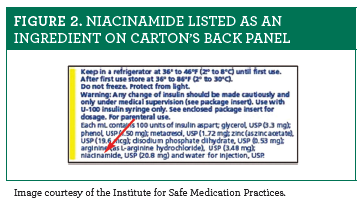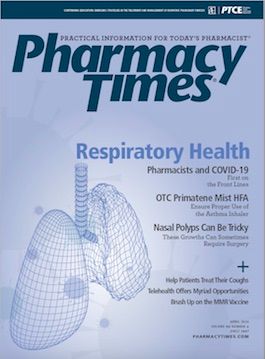Publication
Article
Pharmacy Times
High-Alert Medications Require Special Safeguards
Author(s):
Evaluate the systems in place to protect patients from medication confusion and serious, even fatal, harm.
Medication errors have occurred because of confusion between Fiasp and NovoLog, which are both marketed formulations of insulin aspart 100 units/mL manufactured by Novo Nordisk.
However, Fiasp and NovoLog have different onsets of action after subcutaneous injection and are not substitutable. Fiasp contains niacinamide, which increases the speed of absorption and allows for administration at the start of a meal or within 20 minutes of starting a meal. Patients should administer NovoLog within 5 to 10 minutes before a meal.
Both product container labels have the same nonproprietary name, insulin aspart. The Fiasp package insert lists niacinamide as an inactive ingredient, so the carton does not list this ingredient on the principal display panel (figure 1). Rather, it appears only on the back of the package, along with the list of other inactive ingredients (figure 2).


If insulin aspart is prescribed, pharmacists may dispense either Fiasp or NovoLog if the brand name is not included on the prescription. For example, a prescriber recently ordered Fiasp for a patient and submitted the prescription to the pharmacy electronically. Although he selected Fiasp, the product name included as the e-prescribing drug name was the nonproprietary name insulin aspart. The brand name was not included in the prescription, and NovoLog was dispensed from the pharmacy.
The manufacturer is aware of the potential for mixups and mentions this in company literature, saying that practitioners, particularly pharmacists, should confirm the brand name if it is not specified on the written prescription or in the e-prescribing system. Indeed, for either Fiasp or NovoLog, prescribers should use the appropriate brand name on prescriptions, and electronic order systems should communicate that brand name instead of including only the generic name. Also, practitioners should make patients aware of the differences between the 2 insulins and the product intended for them so they are prepared to check the drug they receive from the pharmacy.
METHOTREXATE ORAL SOLUTION
The methotrexate oral solution Xatmep is meant for pediatric use. The drug is indicated for the treatment of pediatric patients with acute lymphoblastic leukemia (ALL) as part of a multiphase, combination chemotherapy maintenance regimen. It is also approved for use in pediatric patients with polyarticular juvenile idiopathic arthritis who have had an insufficient therapeutic response to or are intolerant of an adequate trial of first-line therapy, including full-dose nonsteroidal anti-inflammatory agents. Each milliliter of the solution contains 2.5 mg of methotrexate. Given that parents sometimes measure liquid doses incorrectly, especially when using teaspoons that vary in volume, dispensing a 120-mL bottle of methotrexate (2.5 mg/mL) for home use is frightening.
Practitioners should dispense all oral liquids with an appropriate dosing device, such as an oral syringe that measures in metric units only, so parents can measure liquid medications accurately. Of critical importance, practitioners should also educate parents about dose measurement using the teach-back method to demonstrate how they will measure each dose accurately. In fact, product labeling recommends telling patients to ask their pharmacists for a proper measuring device and demonstration.
From a patient safety standpoint, this drug is best provided to parents in compounded, prefilled oral syringes containing the exact dose. However, most community pharmacies are not set up to fill and dispense pharmacy-prepared syringes of oral methotrexate (4 syringes per month when dosed weekly). This may require pharmacies and prescribers to coordinate preparation of these syringes with a compounding pharmacy designed to handle pharmacy preparation of hazardous drugs, a hospital pharmacy, or an outsourcer. When educating caregivers or parents, health care practitioners should emphasize that patients take the recommended dose 1 time weekly for either ALL or polyarticular juvenile idiopathic arthritis and that daily use of the recommended dose has led to fatal toxicity.
Given that methotrexate is a chemotherapeutic agent and a hazardous drug, concerns exist about manipulating the drug and discarding unused drugs and used syringes, especially with parents handling the drug in the home. Pharmacy leadership and staff members should discuss and formulate plans about how they will handle and dispense this product and what information they will provide to patients.
Michael J. Gaunt, PharmD, is a medication safety analyst and the editor of ISMP Medication Safety Alert! Community/ Ambulatory Care newsletter at the Institute for Safe Medication Practices in Horsham, Pennsylvania.







